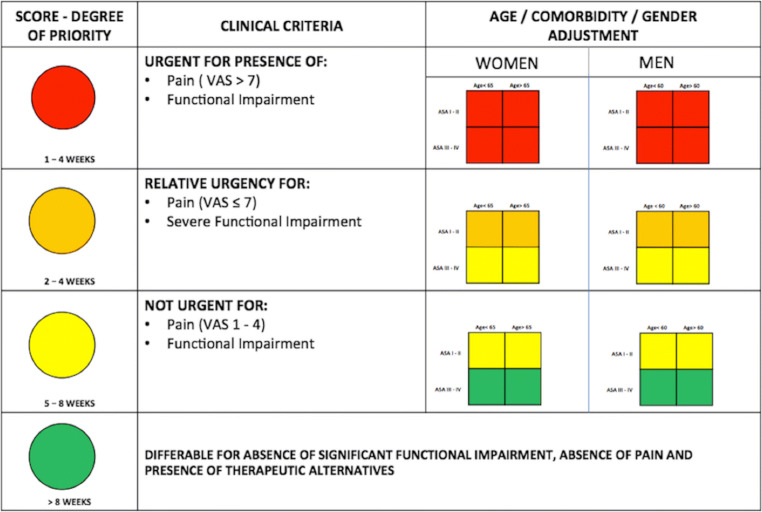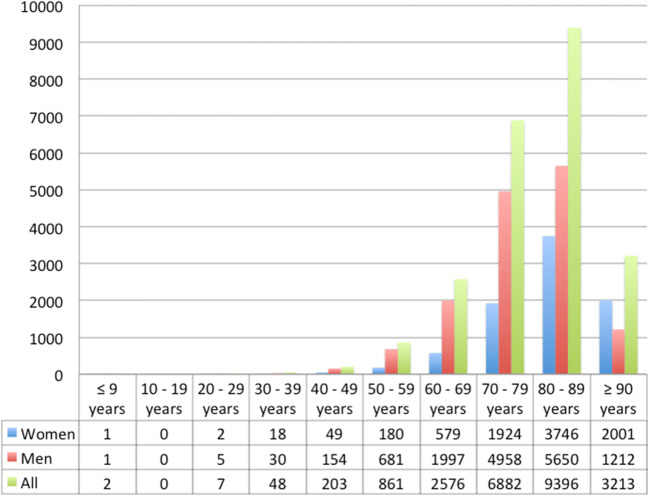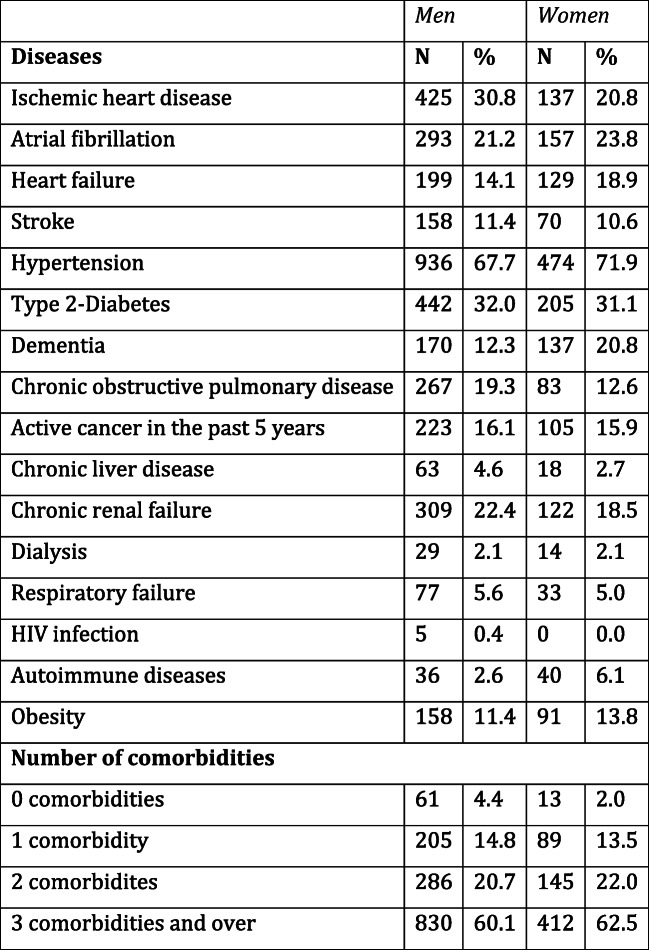Introduction
At our institution in Italy, we developed a protocol to establish treatment recommendations for patients with orthopedic pathology who needed surgery during the COVID-19 pandemic. Our purpose was to guarantee safety for patients, staff, and facility. It is important to keep in mind that a peri-operative SARS-CoV-2 infection could result in higher complication rates for patients with comorbidities [13].
We developed the following critical principles in caring orthopedic patients during the pandemic:
Prevent people with asymptomatic SARS-CoV-2 infection from accessing the hospital and consequently prevent outbreaks on the units.
Create COVID-19-free environments within the hospital; separate these units from those where patients with COVID-19 are treated.
Reduce the risk of contagion in operating rooms.
Reduce hospitalization days to the minimum for patients undergoing essential orthopedic surgery.
Select patients carefully as candidates for surgery during this period of increased risk.
Our protocol included the following adaptations of our normal processes.
Facility requirement: All diagnosis and treatment activities related to surgery for patients not infected with SARS-CoV-2 must be performed in a COVID-19-free environment.
Healthcare staff requirements: Ideally, all staff involved in the management of patient candidates for elective orthopedic surgery should be tested for SARS-CoV-2. Furthermore, all staff should be regularly monitored for infection with checks on a weekly or bi-weekly basis.
Patient selection: Patient selection must take into account age, urgency of treatment, risk of exposure to SARS-CoV-2, American Society of Anesthesiologists (ASA) classification, comorbidity, socio-professional situation, and the possibility of performing post-operative physiotherapy [7, 13].
To screen patients for exposure to SARS-CoV-2 prior to surgery, we assumed six categories in accordance with Feinberg [4] (Table 1).
Patients not known to be exposed or infected. Prior to elective surgery, these patients were assessed with a 48- to 72-h COVID-19 reverse transcription–polymerase chain reaction (RT-PCR) assay.
Patients who were exposed but asymptomatic. Those thought to fall into this category were submitted to a COVID-19 RT-PCR assay, a serological test to detect antibodies, and partial pressure of oxygen (PaO2) measurements in association with chest radiograph.
Patients who recovered from known infection and had potentially developed immunity. This was confirmed by serologic testing before surgery.
Patients with signs and symptoms of COVID-19 but a negative COVID-19 RT-PCR test. These patients had repeat RT-PCR testing, serological testing, and possibly a computed tomography (CT) scan of the chest to aggressively rule out infection.
Patients who were infected (positive COVID-19 RT-PCR test). For these patients, interventions were postponed for 6 weeks, and they underwent serological testing before rescheduled surgery.
Patients who were infected and had comorbidities. Surgery was postponed for these patients until complete recovery, not before 2 months. Serologic tests were performed before surgery.
Table 1.
Stratification of the risk of infection with respect to patient age and Feinberg category
| Category/age | < 40 | 40–60 | − 70 | Over 70 |
|---|---|---|---|---|
| 1 | + | |||
| 2 | + | ++ | ||
| 3 | + | ++ | +++ | |
| 4 | + | ++ | +++ | ++++ |
| 5 | + | ++ | +++ | ++++ |
| 6 | ++ | +++ | ++++ | +++++ |
We considered patients in categories 1, 2, and 3 eligible to undergo elective surgery, regardless of the urgency of the treatment. Patients in categories 4, 5, and 6 required complete recovery and the time to develop an adequate immune response before elective surgery. (However, if these patients did have surgery, the procedure must take place in a separate environment within the hospital and with adequate assessment of the risk to healthcare staff and planning to optimize their ability to avoid infection.) Also, patients classified as ASA I or ASA II had priority for intervention regardless of the urgency of the treatment. It was recommended that patients over 65 years of age [1] or those with risk factors such as obesity, hypertension, cardiovascular disease, and diabetes should not undergo non-emergent surgery in the first phase of the pandemic. Nonetheless, each case was discussed and evaluated individually with anesthesiologists. Finally, the socio-professional situation of each patient, in terms of urgency in the resumption of work, was considered, giving priority to essential workers. Post-operative physiotherapy (if rehabilitation inside the facility is not provided or the possibility of transfer to external rehabilitation) was discussed on a case-by-case basis with each patient.
Therapeutic Clinical Path
Selection of patients was carried out through the review of questionnaires assessing the specific situation of each patient concerning exposure to SARS-CoV-2. These can be administered to the patient via telephone or e-mail. We used this information, in addition to factors including the urgency of surgery and the possibility of post-operative physiotherapy, to organize the waiting list for surgery.
Before hospitalization, a COVID-19 RT-PCR test and/or serological test was performed in addition to the standard pre-operative routine. In some cases, depending on a patient’s category (see categories 1 through 6 above), it was necessary to measure PaO2 or perform a chest X-ray. Abnormal chest X-rays would be followed by a CT scan.
The RT-PCR test was to be carried out 48 to 72 h before the intervention or, preferably, if a rapid response is possible, on the morning of the scheduled procedure. After this screening is performed, ideally, the patient should undergo either preventive home isolation or immediate hospitalization, with continuous monitoring for signs of infection until admission or surgery. All patients should be reassessed on the day of hospitalization. It is our opinion that PCR, D-dimer, and complete white blood cell count tests should be performed. To minimize time spent in the hospital, all surgeries should be same-day admissions.
Pre-operative meetings with physiotherapists—a standard part of our pre-hospitalization preparation—were modified, limiting groups to five patients at a time, always respecting safe social distance. Alternatively, pre-operative preparation can take place virtually on a digital platform, for groups or classes of patients, depending on the type of intervention to be performed. These can also be attended by specialized personnel such as physiotherapists, pain therapy nurses, orthopedists, anesthesiologists, and psychologists.
Surgical Indications
In the first phase of resuming elective surgical activity, we performed surgery on patients with the lowest risk (those belonging to categories 1, 2, and 3, in combination with age and comorbidity criteria), both for their sake and that of staff as well. In general, as specific scientific criteria are not defined, we prioritized minimally invasive elective surgical procedures and those with less blood loss, to guarantee a maximum hospital stay of 2 to 3 days. Among patients on our waiting list for hip and knee surgery, those we considered low-risk were identified through a pre-operative questionnaire and/or telephone interview (Fig. 1).
Fig. 1.
Classification system for performance of surgical orthopedic procedures. VAS, visual analog scale for pain [5].
We agree with the report from Istituto Superiore di Sanità (ISS) that documented a significantly lower mortality rate in the female sex, a finding that allowed us to include women up to age 65 years in the low-risk category [8]. In female patients between 65 and 70 years of age, however, there is a gray area; for these patients, decisions must be made on the basis of the patient selection and safety criteria as well as an anesthesiologist’s judgment (Fig. 2).
Fig. 2.
Absolute number of deaths by age group. Data source: https://www.epicentro.iss.it/en/coronavirus/bollettino/Report-COVID-2019_23_april_2020.pdf.
The ISS report also documented a progressive and significant increase in the number of deaths in patients with preexisting comorbidity [8]. In the absence of comorbidity, the rate of mortality seems to be very low. The number of preexisting comorbidities is significant; compared with the rate of mortality with one comorbidity, the rate of mortality with two comorbidities almost doubles. In the case of a third comorbidity, the rate almost triples. This appears to be identical between the two genders [8] (Fig. 3).
Fig. 3.
Most common comorbidities observed in SARS-CoV-2-positive deceased patients by gender. Data source: https://www.epicentro.iss.it/en/coronavirus/bollettino/Report-COVID-2019_23_april_2020.pdf.
Surgical Intervention
The prevention of the transmission of SARS-CoV-2 from a potentially infected patient inside the operating room was one objective of management protocols. Surgical tools such as drills, oscillating saws, and electrosurgical units facilitate the release of large quantities of aerosols into the air [3]. Consequently, there is a lower risk of contagion during arthroscopic and minimally invasive surgery. The surgical team should not wear commonly used surgical helmets, because these do not have an air fan cover filter. Current recommendations to be used in place of surgical helmets provide for the use of level 4 protective gowns, FFP2 and FFP3 or N95 to N99 respiratory masks, goggles, or masks with a breathing filter [6]. As usual, all surgical personnel should double glove.
Anesthesiology Recommendations
Preprocedural and Management Phase
Perform all invasive procedures, including placement of the epidural catheter and peripheral nerve blocks, in the operating room.
Minimize the number of staff in the operating room.
Ensure the patient continuously wears a surgical mask to reduce the risk of spreading droplets.
Have more experienced staff to carry out the procedures.
Bring medicines, devices, and everything else necessary into the operating room and dispose of it at the end of the intervention.
Keep all medications deemed useful during a procedure in a plastic bag.
Protect the ultrasound screen and keyboard with a disposable plastic cover.
Clean probe covers with hydrogen peroxide at the end of each procedure (no chlorhexidine [2]).
Procedural Phase
Keep sedations to a minimum to allow the patient to wear a surgical mask.
Avoid administrating oxygen at high flows (in case of sedation) and favor nasal cannulas with low flow or surgical masks worn as a face masks.
Monitor oxygenation carefully for COVID-19 patients with respiratory symptoms.
Monitor end-tidal carbon dioxide (EtCO2) in the event of sedation.
Do not connect the CO2 line directly to the patient to avoid contaminating the monitor.
Test the adequacy of anesthesia before surgery to gauge possible failures and avoid having to convert under general anesthesia [9].
Discuss use of the tourniquet with the surgeon and do not use it unless it is strictly necessary.
Perform locoregional anesthesia (ALR) with the usual doses. No dose adjustment is required.
Carefully exclude the presence of thrombocytopenia in case of central blockages in COVID-19 patients [10].
Evaluate D-dimer and fibrinogen in case of central blockages in COVID-19 patients.
Postprocedural Recommendations
Recovery and post-operative monitoring should take place in the operating room to avoid the contamination of other areas.
If continuous epidural or perinervous infusion has been chosen, use devices (electronic pumps) and infusion regimes that limit the number of contacts the ward staff has with the patient.
Post-operative Management
Post-operative plans should aim for early discharge of the patient to reduce hospital stay. This requires coordination between the patient, facility, outpatient physiotherapy service, and/or external rehabilitation facilities. Post-operative management programs must be established before surgery and take into account patient selection, age, comorbidity, and any other patient needs. The optimum decision will be to direct all patients to outpatient physiotherapy, giving priority to younger and more active patients and using the membership in category 1, 2, and 3 patients as the absolute criterion of inclusion. Older patients, those who are not self-employed or those without caretakers who can help them travel to outpatient physiotherapy, must be referred to the internal or external rehabilitation services, respecting the differentiated routes in case of COVID-19-positive patients.
Alternatively, use of a digital platform for patient follow-up is appropriate. This could also be useful in the pre-operative and post-operative phases. Finally, to reduce the number of post-operative check-ups with the surgeon, follow-up could be performed via telephone and/or video call (Telemedicine) [12]. Several units in our facility successfully managed patient follow-up with the smartphone application, Carebox. The complete program including surgical treatment, post-operative physiotherapy management, and follow-up must be discussed and planned with the patient before surgery. Discharge criteria have been identified that can be followed in preparing patients for discharge [11]. These include:
RT-PCR swab test (48 h post-operatively)
Body temperature (< 37°C)
Hemoglobin value (≥ 9g/dL, indicatively and to be assessed case by case)
White blood cell count (< 15,000 per microliter of blood)
Clinical conditions of the surgical wound
Pain, assessed according to visual analog scale score (< 4)
Ability to ambulate and climb stairs independently and to carry out personal hygiene
These criteria are assessed by the physical therapy team and possibly during later patient discussions on digital platforms.
Electronic supplementary material
(PDF 1.19 mb)
(PDF 1.19 mb)
(PDF 1.19 mb)
(PDF 1.19 mb)
(PDF 1.19 mb)
(PDF 1.19 mb)
(PDF 1.19 mb)
Compliance with Ethical Standards
Conflict of Interest
Riccardo D’Ambrosi, MD; Alessio Biazzo, MD; Francesco Masia, MD; Vincenzo Izzo, MD; Norberto Confalonieri, MD; Nicola Ursino, MD; Francesco Verde, MD, declare that they have no conflicts of interest.
Human/Animal Rights
All procedures followed were in accordance with the ethical standards of the responsible committee on human experimentation (institutional and national) and with the Helsinki Declaration of 1975, as revised in 2013.
Informed Consent
Informed consent was waived from all patients included in this study.
Required Author Forms
Disclosure forms provided by the authors are available with the online version of this article.
References
- 1.Centers for Disease Control and Prevention. People Who Are at Increased Risk for Severe Illness. https://www.cdc.gov/coronavirus/2019-ncov/need-extra-precautions/people-at-higher-risk.html. Accessed 16 June 2020.
- 2.Coccolini F, Perrone G, Chiarugi M, et al. Surgery in COVID-19 patients: operational directives. World J Emerg Surg. 2020;15(1):25. doi: 10.1186/s13017-020-00307-2. [DOI] [PMC free article] [PubMed] [Google Scholar]
- 3.Cook TM. Personal protective equipment during the COVID-19 pandemic - a narrative review. Anaesthesia. 2020;75(7):920–927. doi: 10.1111/anae.15071. [DOI] [PubMed] [Google Scholar]
- 4.Fineberg HV. Ten Weeks to Crush the Curve. N Engl J Med. 2020;382(17):e37. doi: 10.1056/NEJMe2007263. [DOI] [PubMed] [Google Scholar]
- 5.Heller GZ, Manuguerra M, Chow R. How to analyze the Visual Analogue Scale: Myths, truths and clinical relevance. Scand J Pain.2016;13:67-75. 10.1016/j.sjpain.2016.06.012. [DOI] [PubMed]
- 6.Hirschmann MT, Hart A, Henckel J, et al. COVID-19 coronavirus: recommended personal protective equipment for the orthopaedic and trauma surgeon. Knee Surg Sports Traumatol Arthrosc. 2020;28(6):1960–1968. doi: 10.1007/s00167-020-06022-4. [DOI] [PMC free article] [PubMed] [Google Scholar]
- 7.Hurwitz EE, Simon M, Vinta SR, Zehm CF, Shabot SM, Minhajuddin A, Abouleish AE. Adding Examples to the ASA-Physical Status Classification Improves Correct Assignment to Patients. Anesthesiology. 2017;126(4):614–622. doi: 10.1097/ALN.0000000000001541. [DOI] [PubMed] [Google Scholar]
- 8.Istituto Superiore di Sanità. Characteristics of SARS-CoV-2 patients dying in Italy: Report based on available data on April 23, 2020. https://www.epicentro.iss.it/en/coronavirus/bollettino/Report-COVID-2019_23_april_2020.pdf. Accessed 16 June 2020.
- 9.Lie SA, Wong SW, Wong LT, Wong TGL, Chong SY. Practical considerations for performing regional anesthesia: lessonslearned from the COVID-19 pandemic. Can J Anaesth. 2020;67(7):885–892. doi: 10.1007/s12630-020-01637-0. [DOI] [PMC free article] [PubMed] [Google Scholar]
- 10.Lippi G, Plebani M, Henry BM. Thrombocytopenia is associated with severe coronavirus disease 2019 (COVID-19) infections: A meta-analysis. Clin Chim Acta. 2020;506:145–148. doi: 10.1016/j.cca.2020.03.022. [DOI] [PMC free article] [PubMed] [Google Scholar]
- 11.Meneghini RM, Ziemba-Davis M, Ishmael MK, Kuzma AL, Caccavallo P. Safe Selection of Outpatient Joint Arthroplasty Patients With Medical Risk Stratification: the "Outpatient Arthroplasty Risk Assessment Score". J Arthroplast. 2017;32(8):2325–2331. doi: 10.1016/j.arth.2017.03.004. [DOI] [PubMed] [Google Scholar]
- 12.Preston N, McHugh GA, Hensor EMA et al. Developing a standardized approach to virtual clinic follow-up of hip and knee arthroplasty. Bone Joint J. 2019;101-B(8):951-959. 10.1302/0301-620X.101B8.BJJ-2018-1566.R1. [DOI] [PubMed]
- 13.Zheng Z, Peng F, Xu B, et al. Risk factors of critical and mortal COVID-19 cases: A systematic literature review and meta-analysis. J Inf Secur. 2020;81(2):e16–e25. doi: 10.1016/j.jinf.2020.04.021. [DOI] [PMC free article] [PubMed] [Google Scholar]
Associated Data
This section collects any data citations, data availability statements, or supplementary materials included in this article.
Supplementary Materials
(PDF 1.19 mb)
(PDF 1.19 mb)
(PDF 1.19 mb)
(PDF 1.19 mb)
(PDF 1.19 mb)
(PDF 1.19 mb)
(PDF 1.19 mb)





